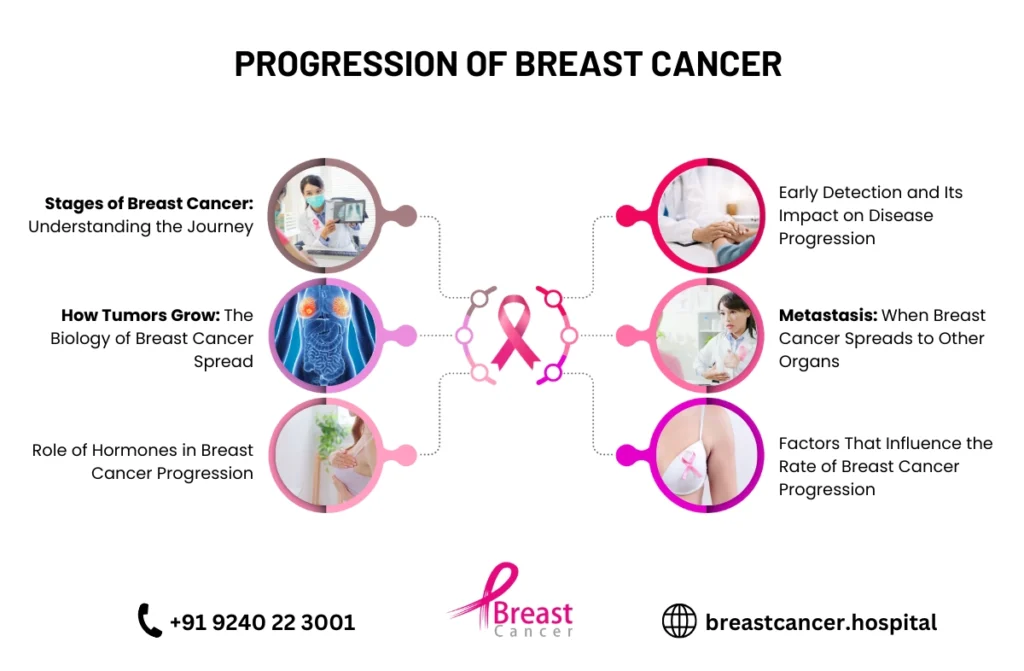The different types of breast cancer can be classified into two main categories: invasive and non-invasive. Invasive cancers, such as advanced breast cancer, spread beyond the breast tissue, while non-invasive cancers remain within the milk ducts. Early-stage breast cancer is easier to treat and has better survival rates. Breast cancer is not a one-size-fits-all condition. It manifests in different forms, each with its unique features and implications, known as the Different Types of Breast Cancer.
Recognizing and comprehending these diverse types is paramount for both patients and healthcare professionals. Understanding variations such as invasive ductal carcinoma, lobular carcinoma, and Types of breast cancer HER2 individuals with knowledge to make informed decisions about their healthcare. By exploring the landscape of breast cancer, we promote proactive health measures, encouraging early detection and tailored treatments based on the specific type, ultimately enhancing outcomes for those affected.
What is Breast Cancer?
Breast cancer is a condition that develops in the cells of the breast and can impact both men and women, although it is more prevalent in women. It arises when abnormal cells in the breast tissue grow uncontrollably, often forming a tumor. These cancerous cells may eventually spread to other parts of the body via the bloodstream or lymphatic system, resulting in advanced stages of the disease. Among the various types of breast cancer, HER2-positive breast cancer is characterized by the overexpression of the Types of breast cancer HER2 protein, which promotes rapid cell growth and requires targeted treatment strategies.
Early-stage breast cancer often remains confined to the breast, and understanding the basics of breast cancer is crucial for ensuring successful treatment outcomes. Factors like genetics, lifestyle choices, and hormone levels play a role in its development. Types of breast cancer, including HER2-positive, invasive, and non-invasive forms, are classified based on their cellular behavior and characteristics.

Different Types Of Breast Cancer
Breast cancer is a diverse disease with different types, each exhibiting unique characteristics. Understanding the various types of breast cancer is crucial for accurate diagnosis and tailored treatment plans. Here’s an overview of some common types:
Ductal Carcinoma in Situ (DCIS)
DCIS, often referred to as stage 0 breast cancer, is a non-invasive condition categorized under different types of breast cancer. In this stage, abnormal cells are found in the lining of a breast duct but have not spread outside the duct.
- Detection through mammograms is common, offering an opportunity for early intervention.
- Treatment may involve surgery, radiation therapy, or a combination of both.
Understanding DCIS is crucial, as it provides a window of opportunity to prevent the progression of abnormal cells into invasive breast cancer.
Invasive Ductal Carcinoma (IDC)
The most prevalent form of breast cancer, IDC, originates in the milk ducts but has the potential to invade nearby tissues.
- IDC accounts for approximately 80% of all breast cancer cases.
- It may present as a lump or thickening in the breast tissue.
- Treatment strategies vary, including surgery, chemotherapy, radiation therapy, and targeted therapies.
Identifying IDC (Invasive Ductal Carcinoma) early is vital for effective treatment and improved outcomes. Regular breast self-exams and screenings are essential for early detection among the different types of breast cancer.
Invasive Lobular Carcinoma (ILC)
ILC begins in the glands that produce milk (the lobules) and can spread to the surrounding tissues.
- It constitutes around 10% of invasive breast cancers.
- ILC may not form a distinct lump, making it challenging to detect through physical examination or mammograms.
- Treatment often involves surgery, hormone therapy, and other targeted therapies.
Understanding the characteristics of ILC is crucial for healthcare providers to tailor treatment plans according to the specific nature of this breast cancer subtype.
Triple-Negative Breast Cancer (TNBC)
TNBC lacks estrogenic receptors, progesterone receptors, and HER2/neu protein, making it distinct from other different types of breast cancer.
- Traditional hormonal therapies and targeted therapies may not be effective.
- Chemotherapy is a primary treatment option for TNBC.
Research is ongoing to develop targeted therapies for TNBC, highlighting the importance of staying informed about advancements in breast cancer treatments.
Early Detection of Breast Cancer
The key to fighting breast cancer effectively is early detection. Catching the disease in its early stages can lead to better treatment outcomes and higher survival rates. Here’s how early detection can make a significant difference:
- Self-examination: Regular breast self-checks help in identifying any unusual changes in the breast tissue.
- Mammograms: Routine screening helps detect early-stage cancers that may not present symptoms.
- Ultrasound and MRI: These imaging methods are often used to further investigate suspicious findings from mammograms.
Stages of Breast Cancer
Breast cancer is staged to determine how advanced the disease is. The stages include:
- Stage 0 (DCIS) – Non-invasive, where abnormal cells are confined to the milk ducts.
- Stage I – Early-stage breast cancer, where the tumor is small and localized within the breast.
- Stage II – Larger tumors or spread to nearby lymph nodes but no distant spread.
- Stage III – Locally advanced cancer, with significant spread to lymph nodes and surrounding tissues.
- Stage IV (Advanced Breast Cancer) – Metastatic cancer, where the disease has spread to distant organs such as the bones, liver, or lungs.
Understanding the stage of breast cancer is crucial for determining the appropriate treatment plan. Early-stage breast cancer has a higher chance of successful treatment, while advanced breast cancer may require more aggressive therapies.
Symptoms
The signs of breast cancer can vary, but common symptoms include:
- Lumps in the Breast – A hard, painless lump or thickening in the breast tissue is one of the most noticeable signs.
- Change in Size or Shape – Any change in the size or shape of the breast should be checked by a doctor.
- Pain or Tenderness – Persistent breast pain or tenderness that doesn’t go away may be a symptom.
- Skin Changes – Redness, dimpling, or puckering of the skin on the breast can be indicative of underlying breast cancer.
- Unusual Nipple Discharge – Discharge from the nipple that is not related to breastfeeding should be investigated.
- Swollen Lymph Nodes – Swelling in the underarm or collarbone area may be a sign that the cancer has spread.
It’s essential to pay attention to these symptoms, as early detection through breast cancer basics increases treatment success.
Causes
While the exact cause of breast cancer is not fully understood, several factors contribute to its development:
- Genetic Mutations – Inherited gene mutations like BRCA1 and BRCA2 significantly increase the risk of developing breast cancer.
- Hormonal Influence – Hormones like estrogen and progesterone can fuel the growth of some breast cancers, particularly hormone receptor-positive types.
- Age – The risk of breast cancer increases with age, particularly after 50.
- Family History – A family history of breast cancer may suggest a genetic predisposition to the disease.
- Lifestyle Factors – Diet, lack of physical activity, and alcohol consumption can influence breast cancer risk.
- Radiation Exposure – Exposure to high levels of radiation, particularly at a young age, increases the likelihood of developing breast cancer.
Identifying these risk factors helps in understanding breast cancer basics and prevention strategies.
Diagnosis of Breast Cancer
Breast cancer basics involves imaging techniques like mammograms, ultrasounds, and MRIs. Biopsies are performed to confirm the cancer type. Staging is essential for determining the progression. Early-stage breast cancer is localized, while advanced breast cancer has spread to other body parts.
- Clinical Examination
- Physicians conduct a thorough clinical breast examination to assess any abnormalities or lumps.
- Imaging Studies
- Mammography: X-ray imaging of the breast to detect abnormalities, including tumors.
- Ultrasound: Sound waves create images, useful for evaluating breast masses.
- MRI: Magnetic resonance imaging for detailed images, often used in specific cases.
- Biopsy
- Tissue samples (biopsy) are collected from suspicious areas for laboratory examination.
- Different types of breast cancer, including Invasive Ductal Carcinoma (IDC) and Inflammatory Breast Cancer (IBC), require specific diagnostic approaches.
- Histopathology
- Examination of biopsy samples under a microscope to determine the type and characteristics of breast cancer cells.
- Genetic Testing
- Evaluation of genetic mutations, such as BRCA1 and BRCA2, to assess breast cancer risk.
- Staging and Grading
- Determining the stage and grade of breast cancer helps in treatment planning.
- Staging considers the size, extent, and potential spread of cancer.
- Multidisciplinary Approach
- A collaborative approach involving oncologists, radiologists, pathologists, and surgeons ensures comprehensive diagnosis and personalized treatment plans.
- Regular Monitoring
- Regular screenings and monitoring are essential for early detection and managing different types of breast cancer effectively.
Accurate diagnosis involves a combination of clinical expertise, advanced imaging techniques, and laboratory analysis. Identifying the specific type of breast cancer guides healthcare professionals in tailoring treatment strategies for optimal outcomes.
What is the Survival Rate for Breast Cancer?
Survival rates for breast cancer depend on factors like cancer type, stage at diagnosis, and treatment.
Early-Stage Breast Cancer Survival Rate
- Stage 0-1: Nearly 99% five-year survival rate with timely detection.
- Stage 2: Around 90% with advancements in treatment.
Advanced Breast Cancer Survival Rate
- Stage 3: Approximately 72%, as cancer spreads to nearby tissues or lymph nodes.
- Stage 4 (Metastatic): Survival is lower, with a five-year rate of around 29%. However, treatments for advanced breast cancer are improving, offering better quality of life and extended survival.
Factors Influencing Survival Rates
- Timeliness of breast cancer basics.
- Individual response to treatment.
- Access to advanced therapies for aggressive forms like TNBC or IBC.
What is the most serious type of breast cancer?
- Inflammatory Breast Cancer (IBC): Regarded as the most serious type, IBC is aggressive and often diagnosed at advanced stages due to rapid growth and the absence of a distinct lump.
- Triple-Negative Breast Cancer (TNBC): Known for its aggressiveness and resistance to hormonal therapies, TNBC lacks estrogen, progesterone, and HER2 receptors, limiting treatment options.
- HER2-Positive Breast Cancer: While treatable, HER2-positive cancer can be aggressive. HER2 is a protein that promotes cancer cell growth and targeted therapies are crucial for management.
- Metastatic Breast Cancer: If breast cancer spreads beyond the breast and nearby lymph nodes to other organs, it becomes metastatic, posing significant challenges in treatment and prognosis.
- Invasive Lobular Carcinoma (ILC): ILC may not form a distinct lump, making it challenging to detect early. It has the potential to invade surrounding tissues, affecting treatment approaches.
Treatment
Breast cancer treatment varies depending on the subtype and stage of the disease. Common treatment options include:
- Surgery – Removal of the tumor or the entire breast (mastectomy) is often necessary.
- Chemotherapy – Uses drugs to destroy cancer cells, often used in advanced breast cancer or as a preventive measure post-surgery.
- Radiation Therapy – Targets specific areas to destroy cancer cells or reduce tumor size.
- Hormone Therapy – Blocks hormones like estrogen that fuel the growth of hormone receptor-positive cancers.
- Targeted Therapy – Targets specific molecules involved in cancer growth, especially for HER2-positive cancers.
- Immunotherapy – Stimulates the body’s immune system to fight cancer.
Each treatment is tailored to the patient’s needs based on the type, stage, and genetic makeup of the cancer, emphasizing the importance of early detection through breast cancer basics.
Complications
Breast cancer surgery, while essential for treatment, may involve complications that patients should be aware of:
- Infection: Surgical wounds can become infected, requiring prompt medical attention.
- Bleeding: Excessive bleeding during or after surgery is a potential complication, necessitating intervention.
- Seroma Formation: Fluid accumulation near the surgical site, known as a seroma, may occur and may require drainage.
- Changes in Sensation: Surgeries like mastectomy may lead to changes in sensation or numbness in the chest area.
- Lymphedema: Removal of lymph nodes can disrupt fluid balance, causing swelling, known as lymphedema.
Being informed about potential complications and discussing them with healthcare providers is crucial for post-surgery care and management. Understanding the different types of breast cancer further aids in tailored treatment plans.
Breast Cancer Prevention
While breast cancer cannot always be prevented, several steps can reduce the risk:
- Regular Screenings – Early detection through mammograms and self-exams can catch cancer in its early stages, leading to better outcomes.
- Healthy Lifestyle – A balanced diet, regular physical activity, and maintaining a healthy weight can reduce breast cancer risk.
- Limit Alcohol and Tobacco – Reducing alcohol intake and avoiding tobacco products can lower the risk of developing breast cancer.
- Breastfeeding – Breastfeeding for an extended period may lower the risk of breast cancer.
- Genetic Testing – For those with a family history, genetic testing for BRCA mutations can help assess risk and guide preventive measures.
- Hormonal Therapy – Discussing the risks of hormone replacement therapy with a doctor can help in making informed decisions.
By making informed lifestyle choices and staying vigilant with breast cancer basics, individuals can significantly reduce their risk of developing this disease.
Conclusion
Recognizing the different types of breast cancer is pivotal for early detection and personalized treatment plans. From non-invasive DCIS to the more aggressive TNBC, each subtype requires a tailored approach to ensure the best possible outcomes for patients. Stay informed, prioritize regular screenings, and consult with healthcare professionals for personalized guidance on different kinds of breast cancer and overall breast health. Understanding the different types of breast cancer helps in early diagnosis and tailored treatment plans. Awareness, regular screening, and timely intervention can significantly impact survival rates. Always consult healthcare professionals for the best course of action.
Also, Read: Best Breast Cancer Hospital in Chennai.




